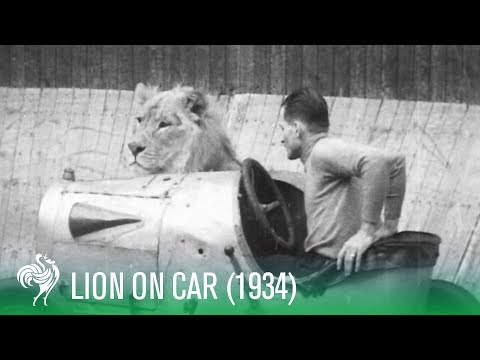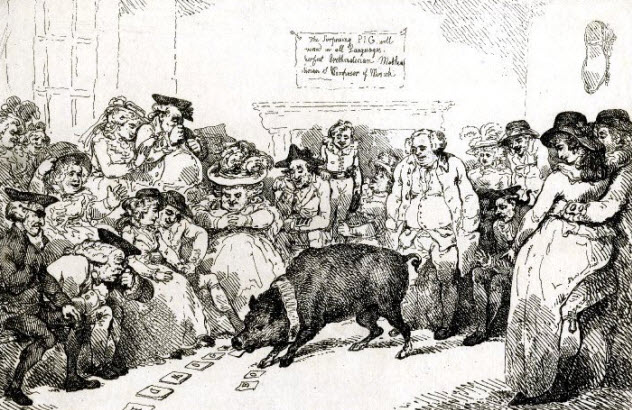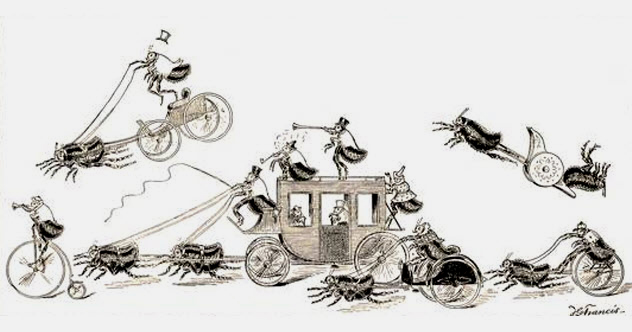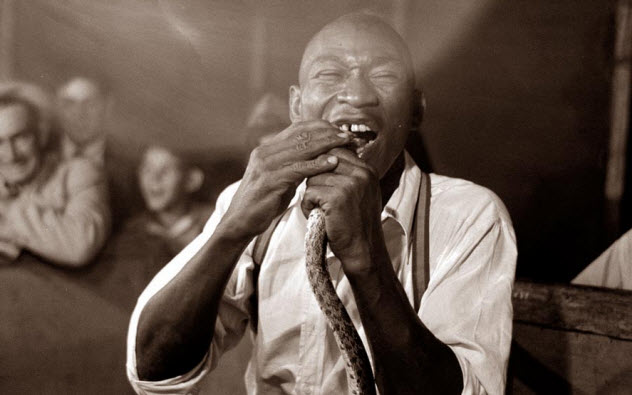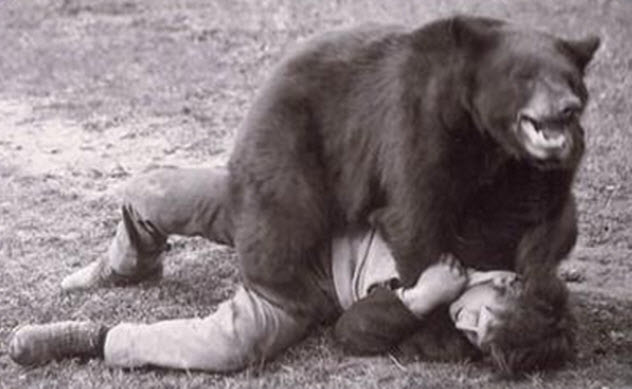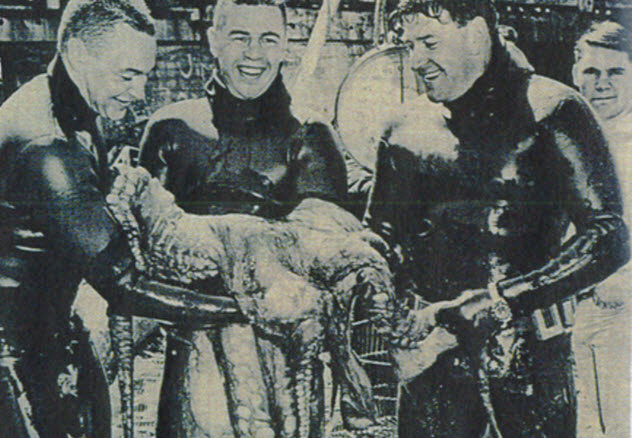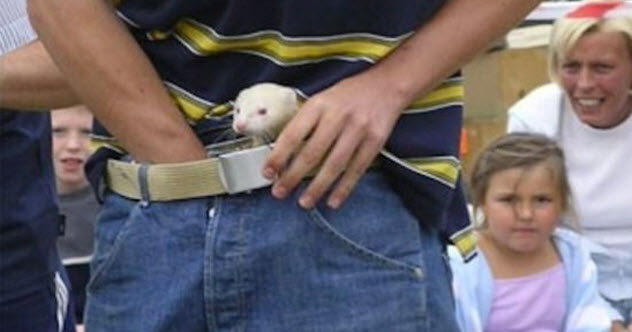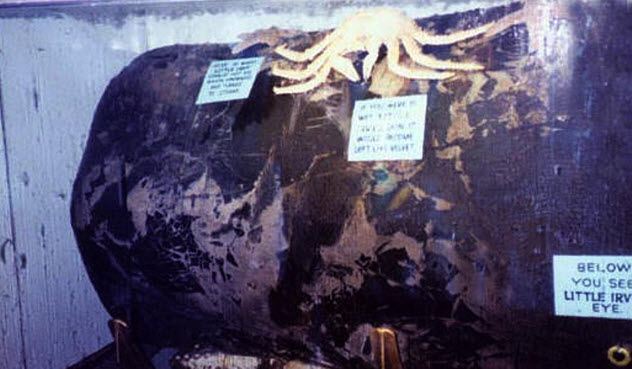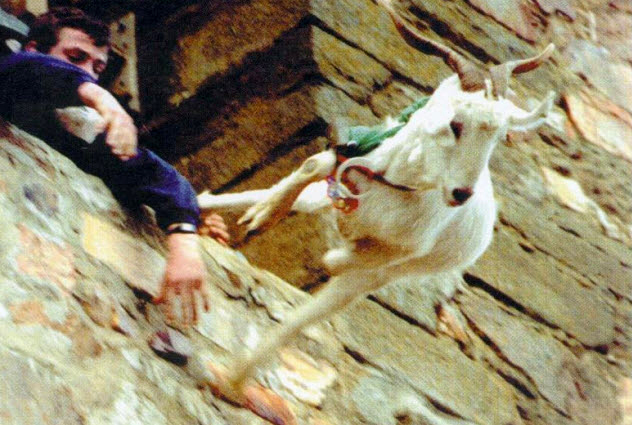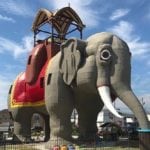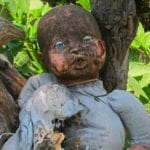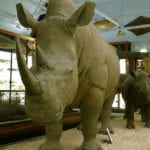10 Lion Drome
In the 1930s, motordromes turned into extremely interesting (and often dangerous) places. Some motorbike stunt riders trained their pet lions to sit in specially built sidecars and then raced madly with the animals by their side. This racing was done at 130 kilometers per hour (80 mph) around the almost perpendicular wall of the motordrome track known as the “Wall of Death!” Believe it or not, sometimes this mad activity was not exciting enough for the participants and spectators. In those cases, an additional element of thrill, known as the “Race For Life,” was introduced. Trained lions were deliberately released and would charge after the zooming motorcycles trying to swat them with their huge paws. The last lion drome closed in 1964 when a drunken carnival worker placed his hand inside a lion cage and had it bitten off by a male lion named King.
9 Learned Pigs
In the 18th and 19th centuries, “learned pigs” were a popular type of entertainment and attracted huge numbers of curious spectators in both England and the US. The owners taught their “learned pigs” a number of impressive tricks, such as spelling and counting with cards, telling the time of day, distinguishing the sexes, and supposedly even reading the thoughts of members of the audience. Through fees and wagers, the owners made quite an income. But it was well deserved since training a pig could take up to two years. Many published works concerning the training of pigs have exposed the tricks used by the pig trainers. For example, the pig was encouraged to move in a specific direction by stick-prodding and was taught to retrieve cards that were scented with food.
8 Flea Circus
The “flea circus,” otherwise known as the “smallest circus in the world,” was a popular Victorian sideshow attraction. The fleas were dressed in miniature costumes and could be seen performing various circus stunts such as tightrope walking, racing, juggling, and pulling miniature carts. Flea circuses took place in a ring that was the size of a dinner plate. It was surrounded by small boxes that served as the houses of the performers and the stables for their carriages. The audience consisted of one person with a magnifying glass and the proprietor who stood nearby, armed with a pair of pincers in case any of his fleas misbehaved. It was thought that circus fleas were of remarkable intelligence, but training them was no easy feat. However, recent reports suggest that these fleas were most likely “mole fleas,” a less energetic variety of the insect. Mole fleas were harnessed with a thin piece of gold wire and stimulated into movement with a heat lamp.
7 Geek Show
In the early 20th century, “geeks” were circus “freaks” whose specialty was biting off the heads of animals (usually those of chickens or snakes) and drinking their blood. Geek shows often inspired the fear that normal people in the audience could also become freaks because geeks were ordinary people otherwise. Geeks were mostly men, although the few women geeks were especially prized because it was uncommon for women to be part of such a violent act. Geeks frequently suffered from broken teeth and jaws, and the constant interaction with animals in close proximity meant that geeks often suffered from animal-related sicknesses. Geeks were also paid the lowest wages because they could be replaced easily.
6 Bear Wrestling
In the early 1900s, bear wrestling was a popular sport that attracted large crowds of people, particularly throughout the southern United States. Often, the bear wrestled with a specific wrestler, usually his owner and trainer. Together, they perfected a choreographed match that they took on the road for everyone to see. Other times, the bear was trained to wrestle with a different person who would play the coward and lose the match to the bear. Still other times, audience members were invited to wrestle the magnificent beast. If the audience member succeeded, he received a cash prize. Of course, most wrestling bears were declawed and detoothed.
5 Diving Horse
A “diving horse,” a popular attraction in the mid-1880s, consisted of a horse diving into a pool of water, sometimes from as high as 20 meters (60 ft). William “Doc” Carver came up with this idea when he crossed a bridge which partially collapsed and his horse fell into the water below. Following World War II, the popularity of the diving horse act declined due to criticism from animal welfare activists. Sometimes, the horses were forced to dive four times a day, seven times a week. The owners of the shows were also accused of using electrical jolts and trapdoors to force the unwilling horses to dive.
4 Octopus Wrestling
Octopus wrestling was a curious sport that was popular in the Puget Sound in Washington in the 1950s and 1960s. The World Octopus Wrestling Championship took place there in 1963 with 111 divers taking part in the match. The sport involved divers wrangling octopuses to the surface of the water and receiving points on the final weight of the octopuses wrestled and the amount of equipment used (snorkels versus breathing tanks). Octopus wrestling was not really “wrestling,” however. Divers simply stuck their hands into the ocean caverns and groped for the heads of the octopuses. Then the diver would pull on the octopus until the suction created by its tentacles was released, allowing the diver to bring the octopus to the surface. Giant Pacific octopuses are timid creatures, so most cases of provocation ended with the octopus giving in or fleeing.
3 Ferret-Legging
“Ferret-legging” was a game that consisted of participants shoving live ferrets down their pants. The pants had to be tied at the ankle so that the ferret could not escape. They also had to be spacious enough to allow the ferret to move about freely, and no underwear was allowed. The ferret had to have all of its teeth and claws intact, and neither the ferret nor the participant could be drugged. The winner of the game was the person who could stand the pain from the ferret’s teeth and claws the longest. In the past, hunters sent muzzled ferrets into the burrows of rabbits and moles to scare them out. However, ferreting became illegal during the Middle Ages, and hunters began hiding ferrets in their pants to get past game wardens. Eventually, ferret-legging became a sport practiced widely in the United Kingdom, especially among Yorkshire miners in the 1970s.
2 Dead Whales
Throughout the 1950s, ’60s, and ’70s, tours showcasing dead whales were a popular attraction that lured thousands of people in the United Kingdom and the United States. The three main preserved whales in the UK were named Goliath, Jonah, and Hercules and were displayed in car parks and large grassy areas such as racecourses. For an entrance fee, the curious spectators could view the whale and various instruments of death such as the harpoon and other whaling tools. The whales were originally caught off the coast of Norway and driven around Europe to promote the whaling industry after World War II. They were eventually sold to showmen who realized their financial potential. The whales were then preserved and scooped out, and their insides were decorated with lanterns.
1 Goat Throwing
On the fourth Sunday in January, goat throwing used to take place in the Spanish village of Manganeses de la Polvorosa in honor of Saint Vincent, the town’s patron saint. The tradition was to carry a live goat to the top of a 15-meter (50 ft) church tower and throw it to the crowd below, who would then catch the goat with a canvas sheet. According to local legend, a priest once had a special goat that could feed all the poor in the village with its milk. One day, the goat accidentally climbed atop the church tower and was so frightened by the church bells ringing for Sunday mass that it fell onto the street below. Amazingly, the goat was caught in a blanket and survived. Thus, the tradition of goat throwing was meant to represent the miraculous survival. Nowadays, the tradition is no longer practiced due to complaints from animal rights activists. As one can imagine, the villagers complained extensively. Supposedly, the mayor of the town also said that having a fiesta without goat throwing is like having Christmas without a Christmas tree. Laura is a student from Ireland in love with books, writing, coffee, and cats.
